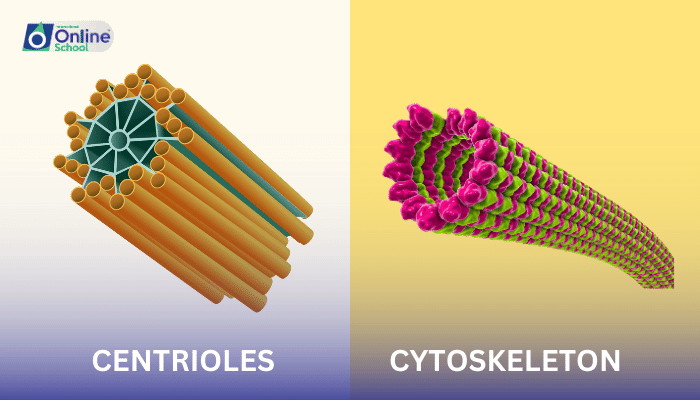
Learning Outcomes
i. Define centrioles and the cytoskeleton.
ii. Describe the structure and composition of centrioles and the cytoskeleton.
iii. Explain the roles of centrioles and the cytoskeleton in cell division and structural integrity.
i. Centrioles: Centrioles are cylindrical organelles that are found in the cytoplasm of most animal cells. They are involved in cell division and in organizing the microtubules of the cytoskeleton.
Structure and composition of centrioles: Centrioles are made up of a protein called tubulin. Tubulin is also the main component of microtubules. Centrioles are made up of nine triplets of microtubules. The triplets are arranged in a circle around a central core.
Function of centrioles: Centrioles play an important role in cell division. They help to form the mitotic spindle, which is a structure that separates the chromosomes during mitosis. Centrioles also play a role in organizing the microtubules of the cytoskeleton. The cytoskeleton is a network of microtubules that provides support and structure for the cell.
ii. Cytoskeleton: The cytoskeleton is a network of protein filaments that runs throughout the cytoplasm of all eukaryotic cells. It provides support and structure for the cell, and it also plays a role in cell movement and division.
Structure and composition of the cytoskeleton:
The cytoskeleton is made up of three types of filaments: microtubules, microfilaments, and intermediate filaments.
- Microtubules are long, hollow tubes that are made up of tubulin. Microtubules are involved in cell division, cell movement, and the maintenance of cell shape.
- Microfilaments are solid filaments that are made up of actin. Microfilaments are involved in muscle contraction, cell movement, and the maintenance of cell shape.
- Intermediate filaments are strong, flexible filaments that are made up of a variety of proteins. Intermediate filaments are involved in supporting the cell and in maintaining cell shape.
Function of the cytoskeleton:
The cytoskeleton plays a variety of important functions in the cell, including:
Support and structure: The cytoskeleton provides support and structure for the cell. It also helps to maintain cell shape.
Cell movement: The cytoskeleton is involved in cell movement. For example, microfilaments are involved in muscle contraction, which allows for movement.
Cell division: The cytoskeleton is involved in cell division. For example, microtubules are involved in the formation of the mitotic spindle, which separates the chromosomes during mitosis.
iii. Relationship between centrioles and the cytoskeleton: Centrioles play an important role in organizing the microtubules of the cytoskeleton. The microtubules of the cytoskeleton extend from the centrioles. This helps to ensure that the microtubules are arranged in a coordinated way, which is important for cell division and cell movement.
Centrioles and the cytoskeleton are essential organelles that play vital roles in cell division and structural integrity. Centrioles help to form the mitotic spindle, which separates the chromosomes during mitosis. The cytoskeleton provides support and structure for the cell, and it also plays a role in cell movement. Centrioles also play a role in organizing the microtubules of the cytoskeleton.